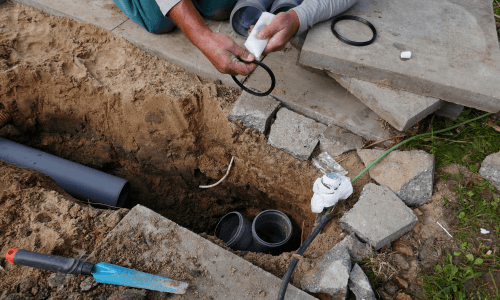
Pros And Cons Of No Dig Pipe Repair
No dig pipe repair, also known as trenchless technology, is an innovative method for repairing underground pipes without the need for extensive excavation. This technology has become increasingly popular due to its minimal disruption and cost-effectiveness. However, like any method, it comes with its own set of advantages and disadvantages. Here, experts from Local Plumber in Florida provide a comprehensive analysis of the pros and cons of no dig pipe repair.1. Understanding No-Dig Pipe Repair
What Is No-Dig Pipe Repair?
No dig pipe repair involves techniques such as pipe lining and pipe bursting to repair or replace damaged underground pipes without the need for extensive digging. This approach preserves the surrounding landscape and infrastructure.Common Techniques
- Pipe Lining (Cured-In-Place Pipe – CIPP): A resin-coated flexible tube is inserted into the damaged pipe and then inflated. The resin hardens to form a new, seamless pipe within the old one.
- Pipe Bursting: The existing pipe is broken apart using a bursting head, while simultaneously pulling a new pipe into place.
2. Pros of No-Dig Pipe Repair
Minimal Disruption
- Less Intrusive: No-dig methods require minimal excavation, reducing the impact on lawns, driveways, sidewalks, and other structures.
- Reduced Noise and Dust: The absence of extensive digging means less noise and dust, making the process less disruptive to residents and businesses.
Cost-Effective
- Lower Labor Costs: Reduced need for manual labor and heavy machinery can lead to significant cost savings.
- Less Restoration Needed: Since there is minimal disruption to the landscape, the costs associated with restoring lawns, driveways, and other areas are greatly reduced.
Time Efficient
- Faster Completion: No-dig repairs can often be completed more quickly than traditional methods, sometimes within a single day.
- Less Downtime: For businesses, this means less downtime and disruption to operations.
Environmentally Friendly
- Less Soil Displacement: No-dig methods disturb much less soil, reducing the environmental impact.
- Reduced Waste: The process generates less waste compared to traditional excavation and replacement.
Durability and Longevity
- High-Quality Materials: The materials used in no-dig repairs, such as epoxy resins, are durable and can extend the lifespan of the pipes.
- Improved Flow: The new lining can sometimes improve the flow within the pipe by reducing friction and preventing future corrosion and leaks.
Versatility
- Wide Application: No-dig methods can be used for a variety of pipes, including sewer, water, and gas lines.
- Access to Hard-to-Reach Areas: Ideal for pipes located under buildings, roads, or other structures where traditional excavation would be challenging.
3. Cons of No-Dig Pipe Repair
Limited Applicability
- Severely Damaged Pipes: Pipes that are completely collapsed or extremely deformed may not be suitable for no-dig repair.
- Size Limitations: No-dig methods may have limitations on the size and length of pipes that can be repaired.
Initial Cost
- Higher Upfront Costs: The technology and materials used in no-dig repairs can sometimes be more expensive initially compared to traditional methods.
Technical Complexity
- Specialized Skills Required: No-dig repairs require specialized training and equipment, which may not be available from all plumbing contractors.
- Potential for Errors: If not performed correctly, no-dig repairs can fail, leading to additional costs and complications.
Inspection and Access Issues
- Pre-Repair Inspection: Detailed inspections are necessary to assess the suitability of no-dig methods, which can add to the overall cost and time.
- Access Points: Creating access points for inserting liners or bursting heads can still require some excavation, albeit minimal.
Material Limitations
- Chemical Resistance: The materials used in some no-dig methods may not be suitable for all types of chemicals that might be present in the sewer or drain systems.
- Temperature Sensitivity: Extreme temperatures can affect the curing process of the resins used in pipe lining.
4. When to Choose No-Dig Pipe Repair
Ideal Situations
- Urban Areas: Where excavation would cause significant disruption to traffic and daily activities.
- Landscaped Properties: To preserve lawns, gardens, and hardscaping.
- Commercial Settings: To minimize downtime and operational disruption.
Assessment and Decision-Making
- Professional Inspection: A thorough inspection by a qualified plumber is essential to determine the suitability of no-dig methods for the specific issue.
- Cost-Benefit Analysis: Compare the long-term benefits and immediate costs of no-dig repairs versus traditional methods.
5. Case Studies
Residential Property
Situation: A homeowner in Tampa noticed sewage backups in their basement. The sewer line was found to be cracked and partially collapsed.Solution:
- Inspection: A camera inspection revealed that the pipe was suitable for pipe lining.
- Repair: The plumber used the CIPP method to reline the damaged sewer line.
- Outcome: The repair was completed in one day with minimal disruption to the property.
Advantages:
- Quick repair time
- No damage to landscaping
Commercial Property
Situation: A commercial building experienced frequent water line leaks due to corroded pipes running under a busy parking lot.Solution:
- Inspection: An inspection showed that pipe bursting was the best solution.
- Repair: The old pipe was burst, and a new pipe was installed without disrupting the parking lot.
- Outcome: The repair was completed over a weekend, preventing any disruption to the business operations.
Advantages:
- No business disruption
- Preservation of the parking lot
6. Future Trends in No-Dig Pipe Repair
Technological Advancements
- Improved Materials: Ongoing research is leading to stronger, more durable materials that can withstand a wider range of conditions.
- Robotic Technologies: Innovations in robotic technology are making no-dig repairs even more precise and efficient.
Broader Applications
- Increased Adoption: As the technology becomes more widely available and cost-effective, more homeowners and businesses are likely to adopt no-dig solutions.
- Regulatory Support: Growing recognition of the environmental and logistical benefits of no-dig methods is leading to increased regulatory support and incentives.
Conclusion
No-dig pipe repair offers numerous benefits, including minimal disruption, cost-effectiveness, and environmental friendliness. However, it is not without its limitations, such as initial costs and technical complexity. By understanding the pros and cons, property owners can make informed decisions about the best approach for their specific plumbing issues. Regular inspections and consultations with experienced professionals, like those at Local Plumber in Florida, can help determine the most suitable and effective repair methods for maintaining the integrity and functionality of underground pipes.
Choosing the right method for pipe repair is crucial for ensuring long-term solutions and minimizing future problems. With the advancements in no-dig technology and its growing accessibility, more property owners can benefit from these innovative repair techniques. By prioritizing no-dig methods where applicable, communities can enjoy the advantages of efficient, cost-effective, and environmentally friendly pipe repair solutions.
Contact us today to learn more about maintaining your water heater and how it can benefit your home and family. Email us at services@local-plumber.com or call us at (833) 247-7667 (POOP).





Leave a comment